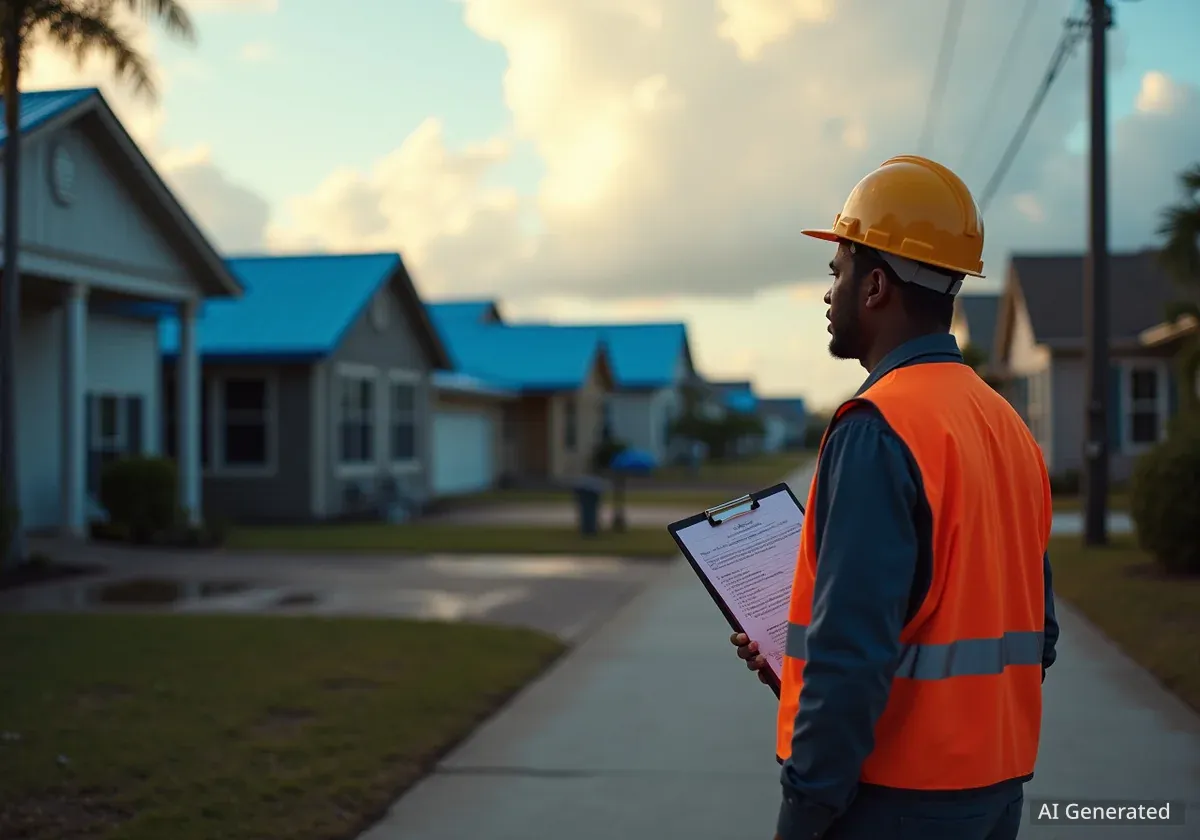Florida is facing a significant challenge in its housing and homeowners insurance markets, driven by increasing climate-related risks like hurricanes and rising sea levels. Private insurance companies are leaving the state, causing premiums to rise and forcing millions of residents to rely on a state-backed insurer. This situation provides important insights for California, which is dealing with its own insurance market instability due to wildfire risks.
Key Takeaways
- Climate change is destabilizing Florida's property insurance market, leading to an exodus of private insurers.
- The state relies on a government-backed entity, Citizens Property Insurance, which has grown to become the largest insurer in Florida.
- Florida has enacted legal reforms and new disclosure laws to manage the crisis, offering a potential roadmap for other states.
- California faces similar challenges with its insurer of last resort due to escalating wildfire risks, making Florida's experience highly relevant.
Florida's Escalating Climate Threats
Florida's geography makes it uniquely susceptible to climate change. The state's extensive coastline and low elevation create a high-risk environment for homeowners and insurers. This vulnerability is compounded by rapid population growth, particularly in coastal areas.
Sea-Level Rise and Flooding
With over 8,400 miles of shoreline, Florida is on the front lines of sea-level rise. According to the National Oceanic and Atmospheric Administration (NOAA), tides in Miami are already more than five inches higher than they were in 1996. Projections suggest South Florida could see an additional 10 to 17 inches of sea-level rise by 2040.
This issue is not just coastal. The state's porous limestone foundation allows saltwater to intrude from below, threatening freshwater supplies and infrastructure like septic systems.
By the Numbers: Florida's Risk
Since 1980, Florida has sustained over $400 billion in damages from hurricanes, the highest of any state in the U.S. This figure highlights the immense financial exposure tied to its real estate market.
The Changing Nature of Hurricanes
Hurricanes have always been a part of life in Florida, but their intensity is increasing. Warmer ocean and air temperatures provide more energy for storms, resulting in higher wind speeds and more extreme rainfall. For example, in April 2023, a weather event known as a "rain bomb" dropped over 25 inches of rain on Fort Lauderdale in a single 24-hour period.
Storms like Hurricane Ian in 2022 also caused severe flooding hundreds of miles inland, demonstrating that the risk extends far beyond the immediate coastline.
A Decades-Long Insurance Struggle
Florida's modern insurance crisis began with Hurricane Andrew in 1992. The storm's devastation bankrupted nearly a dozen insurance companies and prompted many others to withdraw from the state. This event reshaped the market and led to significant government intervention.
The Post-Andrew Restructuring
In the wake of Hurricane Andrew, Florida established the Florida Hurricane Catastrophe Fund (FHCF) in 1993. This fund acts as a reinsurer, providing a financial backstop to private insurance companies to encourage them to remain in the market. This structure remains central to Florida's insurance system today.
The State as the Last Resort
To prevent a total market collapse, Florida operates three key state-regulated entities:
- Citizens Property Insurance Corporation (Citizens): The state-run insurer for homeowners who cannot find private coverage.
- Florida Hurricane Catastrophe Fund (FHCF): A state reinsurance program that offers lower-cost coverage to private insurers.
- Florida Insurance Guaranty Association (FIGA): An organization that covers claims for insolvent private insurance companies.
These programs are primarily funded through assessments on nearly all insurance policies in the state, not just home insurance. This effectively spreads the high cost of coastal risk across the entire population of Florida.
"The concentration of risk in a state-backed entity is perilous. A major storm could easily deplete its reserves, requiring massive assessments on all Florida insurance policyholders or a taxpayer-funded bailout."
The growth of Citizens Property Insurance has been explosive. Between 2017 and 2022, its policy count more than tripled. By 2023, it held 1.4 million policies, making it the largest property insurer in the state. Recent efforts to move policies back to the private market have reduced this number to around 851,000 as of March 2025.
Impact on the Housing Market
Despite the insurance turmoil, Florida's real estate market has shown resilience. However, signs of strain are becoming apparent as buyers become more aware of climate-related risks.
The Emergence of a 'Climate Risk Discount'
Research suggests that properties with high climate risk are beginning to lose value relative to safer homes. One analysis estimates that from 2005 to 2023, high-risk properties across Florida lost a collective $5 billion in relative value. Projections indicate that by 2050, flood-exposed homes could be devalued by $30 to $80 billion.
Real estate data also shows that homes located in federally designated flood hazard areas tend to stay on the market longer. The added difficulty and expense of obtaining flood insurance can slow down or even prevent sales.
Rising Premiums and Insolvencies
The financial pressure on insurers is immense. In 2022, property insurers paid out over $100 billion in claims, a 50% increase from the yearly average in the 2010s. Since 2020, 15 property insurers in the state have declared insolvency, further shrinking the private market and pushing more homeowners toward Citizens.
Policy Responses and Lessons for California
Florida's government has implemented several policies aimed at stabilizing the insurance market. These actions focus more on managing financial consequences than on addressing the underlying physical vulnerabilities.
Florida's Strategy
The state has pursued a multi-pronged approach to lure private insurers back and reduce the burden on Citizens:
- Tort Reform: A 2023 law (HB 837) significantly limited the ability of homeowners to sue insurance companies, a move designed to reduce insurers' litigation costs.
- Forcing Depopulation: New rules require homeowners to accept a private insurance offer if it is within 20% of the premium offered by Citizens, even if it is more expensive.
- Flood Risk Disclosure: A 2024 law now requires sellers to disclose a property's flood history to potential buyers, increasing transparency in real estate transactions.
These strategies offer valuable, if complex, lessons for California. The state is grappling with a shrinking private insurance market due to wildfire risk and a growing reliance on its own insurer of last resort, the FAIR Plan.
A Path Forward for At-Risk States
The parallels between Florida and California are striking. Both are large, populous states with high-value real estate and extreme exposure to natural disasters. Florida's experience demonstrates that mandating risk disclosure is a crucial first step. Furthermore, its aggressive, though controversial, efforts to manage its state-backed insurer provide a case study in financial risk management.
As climate impacts intensify, states like California may benefit from studying Florida's policy experiments. The challenges in Florida's housing and insurance markets serve as a clear warning about the economic consequences of climate change and the difficult policy choices that lie ahead.





